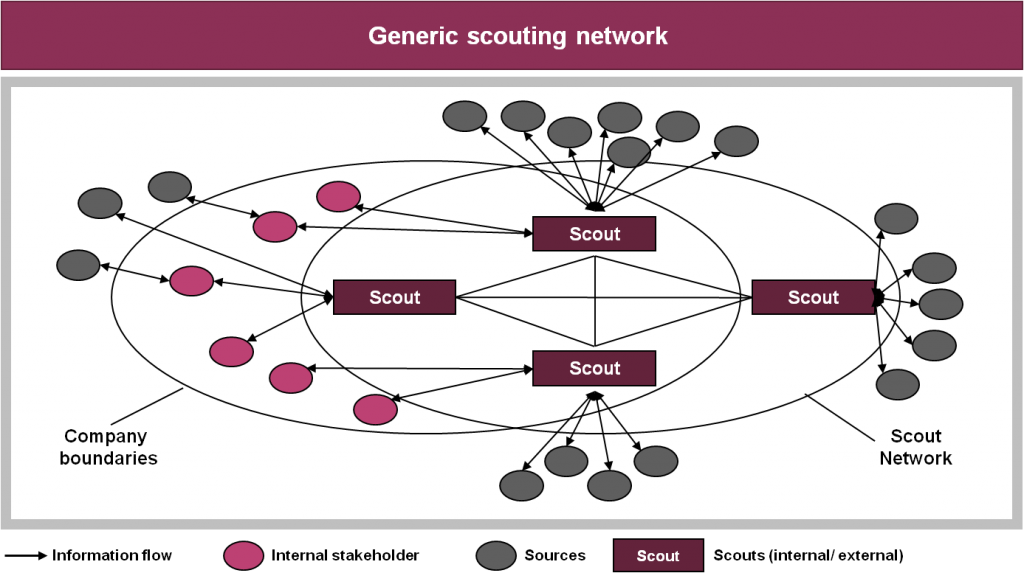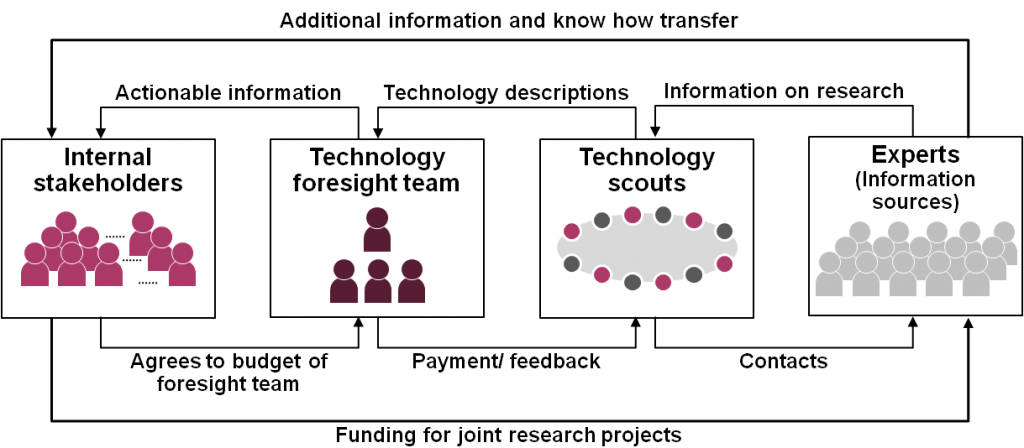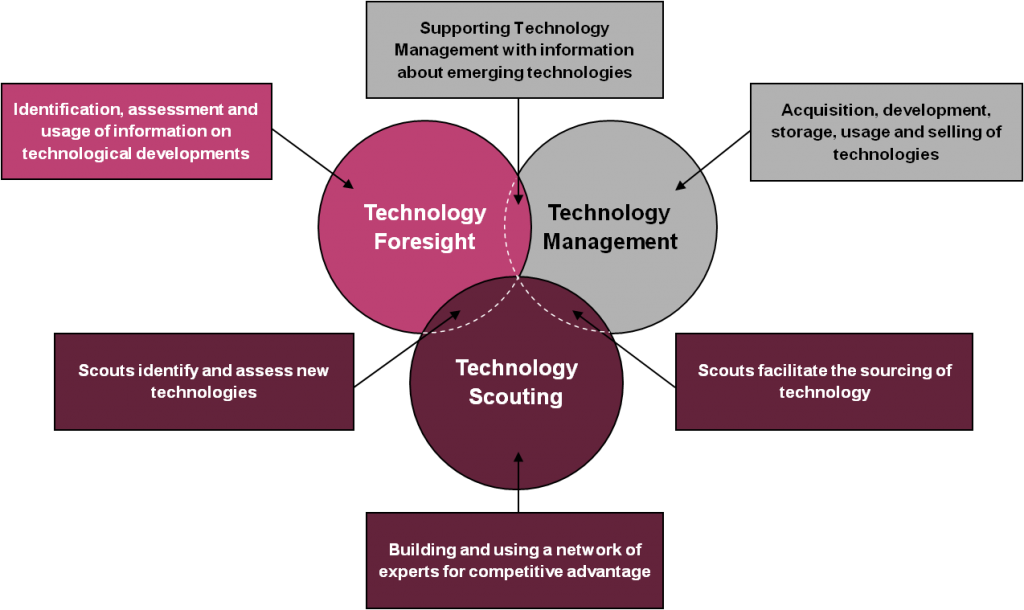 Organizational future orientation is build through identifying and interpreting change in the environment and systematically taking action to build a competitive advantage. One tool which we want to discuss today is Technology Scouting.
Organizational future orientation is build through identifying and interpreting change in the environment and systematically taking action to build a competitive advantage. One tool which we want to discuss today is Technology Scouting.
The general idea of technology scouting is simple: Use a network of experts to scan the technological environment, monitor key technologies and channel the information into the company. On the basis of the information companies might react in different ways:
- assessing the risk from a new and disruptive technology
- planning own research and development (R&D) activities in the new technological field
- preparing the acquisition of the emerging technology by for example licensing, acquiring the Intellectual Property Right (IPR) or buying the company
In all cases the company will have to get additional information, reach out the the source of the initial information and start interacting with the respective organization. Therefore Technology Scouting is a combination of Foresight and Technology Management (see figure 1).
Figure 1: Definition of technology scouting, source: Rohrbeck 2010, p.3
To ensure effective inflow and utilization of insights on emerging technologies the companies build internal and external networks of scouts. These scouts can be internal employees or external consultants. Desired characteristics are lateral thinker, knowledgeable in science and technology, respected inside the company, cross-disciplinary orientated, and imaginative. The scouts serve as central nodes within a network that channel information and create links that can be used to trigger collaborations between partners within the network (see figure 2).
 Figure 2: Generic scouting network, source: Rohrbeck 2010, p. 6
Figure 2: Generic scouting network, source: Rohrbeck 2010, p. 6
The primary difference between an effective and an ineffective scouting network is its ability to create value creating relationships between the participants. Many companies create scouting activities with the expectation that (1) external sources will always be happy to share their insights into emerging technologies or that (2) they just have to pay consultants to search and retrieve the needed information. Often these endeavours end when the company is tired of paying large amounts of money for information that is neither good nor usable to create a competitive advantage.
Another way to organize is shown in figure 3. Here the four primary actors within the scouting network are linked through value adding relationships that create stability. Particularly crucial for long-term sustainability is the relationship between the internal stakeholders, who are the ones that take the actions (e.g. acquire technologies) and the external experts, that supply the information and are eager to engage into joint R&D projects.  Figure 3: Value adding relationships in a scouting network, source Rohrbeck 2010, p. 7
Figure 3: Value adding relationships in a scouting network, source Rohrbeck 2010, p. 7
For more details read the full article: Rohrbeck, R. 2010. Harnessing a network of experts for competitive advantage – Technology Scouting in the ICT Industry. R & D Management, 40(20): 169-180.

6 Responses to “Technology Scouting – from insight to action”
Theoretical foundation: Dynamic Capabilities | Organizational Future Orientation
[…] About us You are here: Home > Bibliography > Theoretical foundation: Dynamic Capabilities ← Technology Scouting – from insight to action […]
Maree Conway
Hi Rene
Could your technology scouts be staff in the company rather than paid consultants? Most staff will have networks internal and external to the company, and most will have views on technology, its values and how it might evolve. For me, giving staff the opportunity to be involved in scanning and to share their views is more important than employing consultants to scan – if you want the scanning process to be integrated into the organisation’s work. Staff will need training in how to scan, and will need to hold certain capabilities as you point out, but involving them as opposed to paying big money for consultants is likely to be more effective for your understanding of technology trends over the long term. So, in a sense, your staff and their networks, becomes your network of experts, and your technology foresight team becomes a core team for assessing and interpreting the scouting output, and identifying possible action.
Cheers
Maree
René Rohrbeck
Hi Maree,
indeed, the companies that I visited had most of the time a combination of internal and external technology scouts. They commented that internal scouts are better at (1) identifying trends with a high relevance for the company, (2) disseminating the information and (3) suggesting application areas of new technologies. The external scouts have there advantages when you look for people that are (1) not blinded by dominant mindsets, (2) are in places which you cannot reach with your internal people and (3) look into true “white spaces” that have almost nothing to do with your current business. In the full article (on page eight) I have also a diagram that classifies scouts into internal vs. external and full-time vs part-time. It shows that Deutsche Telekom has a balanced portfolio along these dimensions.
Cheers
René
Inter-organizational collaboration for foresight | Organizational Future Orientation
[…] joint foresight, where typically firms have a buyers-suppliers relationship or are connected through their scout networks […]
Are firms really so bad at interpreting trends? | Organizational Future Orientation
[…] a trend they failed to produce a adequate response (see our discussion in these previous posts: 1 and […]
Technology scouting | Badegar
[…] Technology Scouting – from insight to action | Organizational Future …Sep 4, 2010 … One tool which we want to discuss today is Technology Scouting. The general idea of technology scouting is simple: Use a network of experts … […]